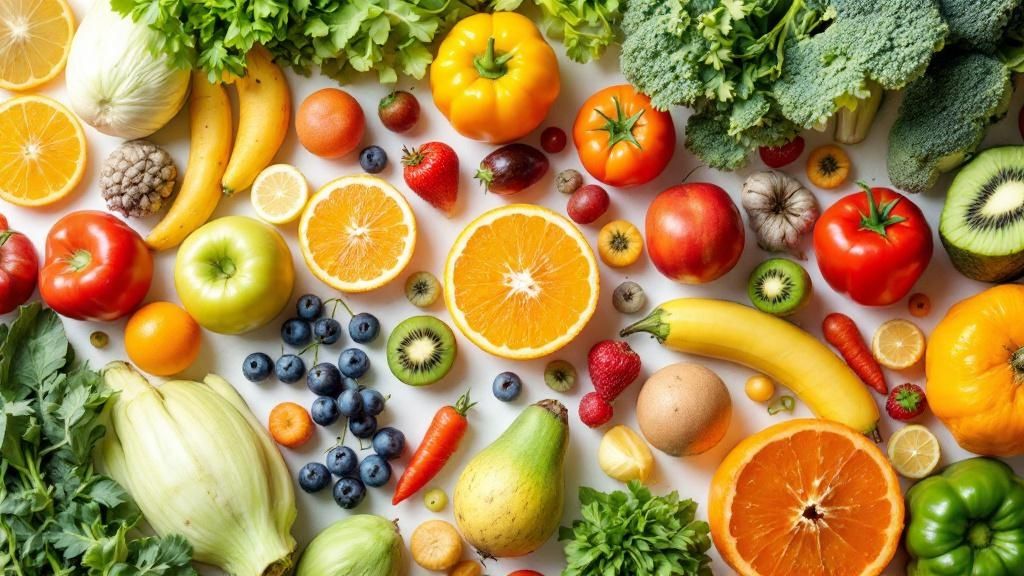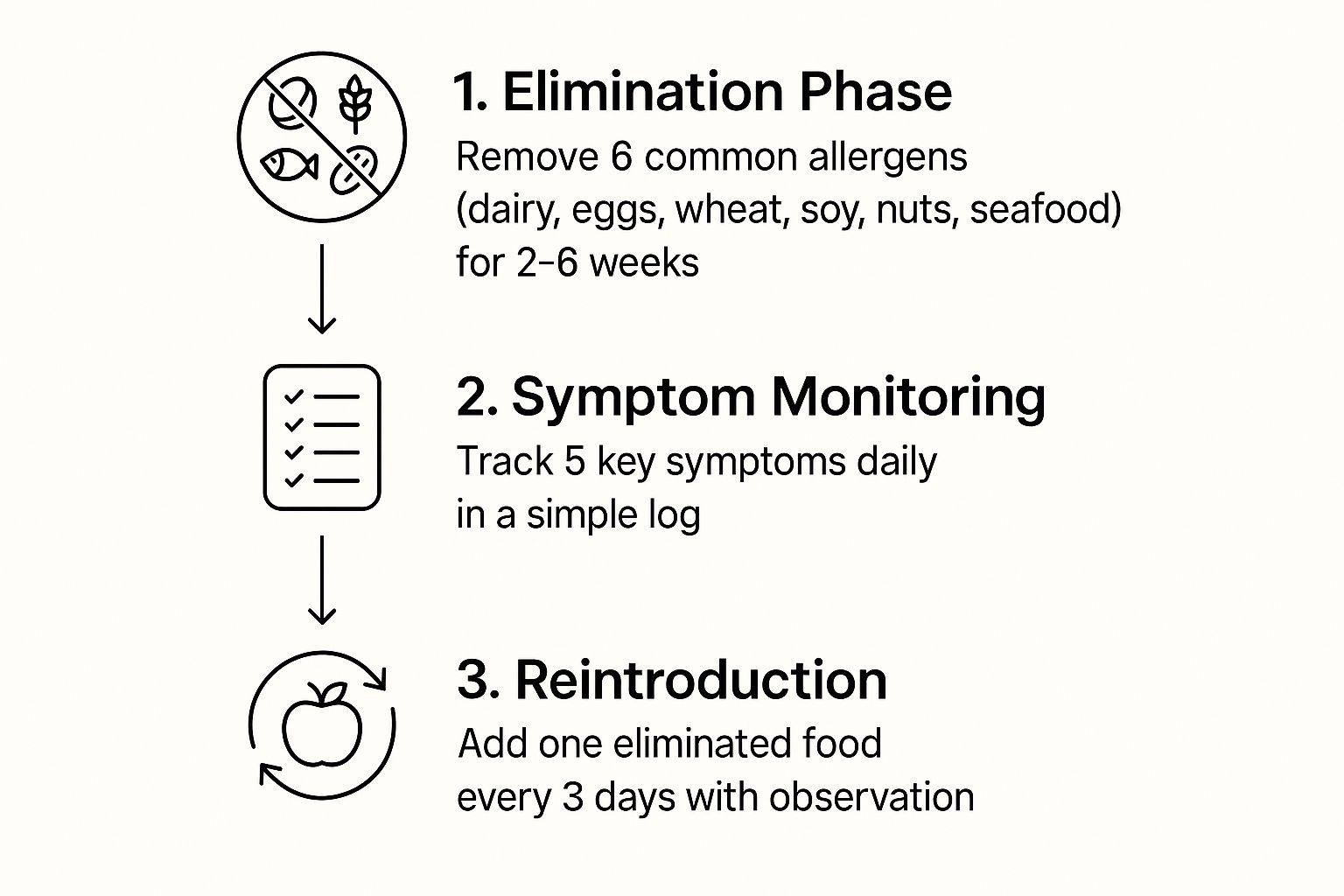
An elimination diet is far more than just a temporary eating plan. Think of it as a focused investigation into your own body, designed to uncover the specific foods causing symptoms like digestive upset, skin issues, or inflammation. It’s a short-term, methodical process: you remove certain foods, give your body a chance to reset, and then reintroduce them one by one to see how you react. This isn't about weight loss; it's about connecting the dots between what you eat and how you feel.
Understanding the Elimination Diet and Your Body

Before you clear out your pantry, it’s critical to grasp the "why" behind this approach. An elimination diet is essentially a science experiment where you are the subject. The first phase is all about creating a clean slate. By removing the most common inflammatory foods, you give your body’s immune and digestive systems a much-needed break from the constant fight.
Once your symptoms have calmed down, you move into the reintroduction or "challenge" phase. This is where the real insights happen. By bringing foods back into your diet one at a time, you can pinpoint exactly which ones are the troublemakers.
Why Target Common Allergens First
Food allergies are a significant issue, affecting an estimated 3% to 4% of adults and up to 6% of children in the United States alone. Because a handful of foods are responsible for the vast majority of these reactions, it makes sense to start there.
This is often called the six-food elimination diet (6-FED), and it hones in on the usual suspects. This strategy dramatically increases your odds of finding the source of your symptoms quickly.
To give you a clearer picture, here’s a quick look at the foods most commonly targeted in an elimination diet and why they make the list.
Common Foods Targeted in an Elimination Diet
A quick look at the most common food allergens, their typical sources, and why they are prioritized in an elimination diet plan.
| Allergen Group | Common Food Sources | Reason for Inclusion |
|---|---|---|
| Milk | Cheese, yogurt, butter, whey protein, casein | One of the most frequent triggers for both true allergies and lactose intolerance. |
| Eggs | Baked goods, mayonnaise, custards, some pastas | Often linked to skin reactions like eczema and digestive problems. |
| Soy | Tofu, edamame, soy milk, soy sauce, many processed foods | A common hidden ingredient that can cause a range of symptoms. |
| Wheat | Bread, pasta, cereal, crackers, baked goods | The primary source of gluten, a well-known inflammatory trigger for many. |
| Nuts | Peanuts, almonds, walnuts, cashews, pecans | Includes both tree nuts and peanuts, known for causing severe allergic reactions. |
| Fish & Shellfish | Salmon, tuna, cod, shrimp, crab, lobster | Potent allergens that can trigger immediate and severe responses. |
By starting with this core group, you're not just guessing—you're following a proven path to identify what might be causing your discomfort.
An elimination diet is fundamentally about listening to your body. It moves beyond guesswork and provides concrete evidence of how specific foods impact your unique system, empowering you to take control of your health with confidence.
Setting Realistic Expectations for Your Journey
It’s also important to understand the difference between food allergies, sensitivities, and intolerances. A true food allergy causes an IgE immune response that can be swift and severe. In contrast, sensitivities and intolerances often result in delayed, less obvious symptoms like bloating, brain fog, headaches, or fatigue. The good news is that an elimination diet can help uncover all three.
For those who want a head start before changing their diet, exploring options like the BARB N.P. Environmental & Food Allergy IgE Test can offer valuable insights into potential IgE-mediated allergies. This allows you to begin your journey with a clearer, more informed perspective.
How to Prepare for the Elimination Phase

Let’s be honest: a successful elimination diet starts long before you take that first bite of a "safe" meal. Think of this prep phase as your mission control. Getting it right is the difference between a clear, manageable process and weeks of frustration. It’s your chance to set the stage for real answers.
Your first move? A full-scale kitchen audit. You need to go through your pantry, fridge, and freezer with a fine-tooth comb. The mission is to find and temporarily remove every single potential trigger on your list. This isn’t just cleaning out; it’s about creating a safe zone for the next few weeks.
This means you're going to have to become an expert label-reader, and fast.
Master the Art of Reading Labels
Hidden allergens are everywhere. I'm talking about sauces, dressings, broths, and countless other packaged goods. Manufacturers use all sorts of sneaky names for common triggers, so you need to learn the lingo. For example, seeing "casein" or "whey" on a label means milk is in there.
Don't get overwhelmed. Just start with a few labels at a time. Before you know it, you'll be spotting problem ingredients from a mile away. This skill is crucial for the initial kitchen clean-out and for every single grocery trip that follows.
Strategic Meal Planning for Success
Once your kitchen is a certified safe zone, it's time to plan. Because staring into an empty fridge wondering what on earth you can eat is the fastest way to give up. The key is to map out your meals and snacks for at least the first week.
Keep it simple and focus on whole foods. Think in categories:
- Proteins: Chicken, fish, turkey, lentils.
- Vegetables: Broccoli, sweet potatoes, spinach, leafy greens.
- Fruits: Berries, apples, bananas.
- Healthy Fats: Avocado, olive oil, seeds.
Build a shopping list from your meal plan and stock up. Having all the right ingredients on hand makes it so much easier to throw together a satisfying meal without stressing. This is how you avoid feeling restricted and stay on track.
Remember, the goal is not deprivation. It's about nourishing your body with foods that make you feel good. A well-stocked kitchen filled with safe, delicious options is your single greatest ally.
Build Your Support System and Mental Fortitude
An elimination diet is as much a mental game as it is a physical one. There will be tough days, social events, and cravings. This is where your support system becomes non-negotiable.
Talk to your close friends and family. Explain what you're doing and why. When people understand your goal, they're more likely to become your biggest cheerleaders instead of accidentally derailing your progress.
Managing multiple food allergies is a serious challenge, particularly with kids. Clinical studies have shown that young patients often end up removing a median of eight foods based on test results and fears of cross-contamination. You can learn more about the complexities of managing multiple food allergies to get deeper insights into this journey.
Finally, get crystal clear on your "why." Are you trying to solve gut issues? Clear up your skin? Figure out what’s causing chronic fatigue? Keeping that goal front and center is the fuel you'll need to see this through and finally get the answers you deserve.
What You'll Eat and What You'll Ditch

This is where the real work begins. For the next 4 to 6 weeks, you’re going to hit the reset button on your system. The goal here is simple: calm everything down by eating only foods that are very unlikely to cause a reaction. This creates a clean slate, a baseline that will make it much easier to spot the culprits later.
Think of your plate as a simple, nourishing foundation. This phase isn’t about starving yourself; it’s about intentionally choosing whole foods that your body can handle with ease.
Building Your "Safe Foods" List
Your grocery list is about to become your most trusted guide. You'll want to pack it with nutrient-dense foods that keep you feeling full and prevent the dreaded "diet boredom." The trick is to find variety within the categories you can eat.
Here's what your go-to food groups will look like:
- Lean Proteins: Keep it simple with chicken, turkey, or certain types of fish (as long as fish isn't a suspected trigger). For plant-based folks, lentils and quinoa are fantastic choices.
- Low-Allergen Veggies: Most vegetables are fair game. Load up on leafy greens like spinach and kale, cruciferous options like broccoli and cauliflower, and root veggies like sweet potatoes and carrots.
- Simple Fruits: Apples, pears, bananas, and most berries are generally well-tolerated. They're perfect for satisfying a sweet tooth while giving you a boost of fiber and vitamins.
- Gluten-Free Grains: Forget wheat for now. Quinoa, rice, and buckwheat are excellent, versatile bases for building satisfying meals.
- Healthy Fats: Don't skip these! Avocado, olive oil, and seeds like pumpkin or sunflower (assuming nuts are out) provide essential fatty acids that support your body.
With this framework, you can craft countless meal combinations that are both delicious and compliant. It makes the entire process feel less like a chore and more like a focused wellness project.
To help you picture what this looks like in practice, here is an example of what three days of meals could look like during the elimination phase.
Sample 3-Day Compliant Meal Plan
| Day | Breakfast | Lunch | Dinner | Snack |
|---|---|---|---|---|
| Day 1 | Cooked quinoa with sliced banana and a sprinkle of sunflower seeds | Large spinach salad with grilled chicken, cucumber, carrots, and an olive oil vinaigrette | Baked salmon with roasted broccoli and sweet potato wedges | A handful of blueberries |
| Day 2 | Green smoothie with spinach, a pear, and water | Leftover baked salmon and veggies | Turkey meatballs (no breadcrumbs) with zucchini noodles and a simple tomato-free sauce | Sliced apple |
| Day 3 | Buckwheat porridge with a few berries | Lentil soup (made with compliant vegetable broth) and a side of mixed greens | Turkey stir-fry with rice, broccoli, and carrots (use coconut aminos instead of soy sauce) | Rice cakes with avocado |
This is just a starting point, of course. The key is to find simple, whole-food recipes you enjoy and can rotate to keep things interesting.
How to Protect Your Progress from Cross-Contamination
Even a microscopic amount of an allergen can throw off your results. Cross-contamination is the silent enemy of an elimination diet, and it can happen right in your own kitchen or when you’re eating out.
At home, you'll need to be meticulous. Use separate cutting boards, knives, and even toasters for your "safe" foods. When dining out, a little prep work goes a long way. Call the restaurant ahead of time to ask about how they handle food allergies. When you order, be polite but firm about your needs, asking that your food be prepared on a clean surface with clean utensils.
The success of your elimination diet hinges on being strict. A small slip-up with cross-contamination can trigger inflammation, making it impossible to get a clear picture of what’s really going on when you start reintroducing foods.
Filling Nutritional Gaps with Smart Supplementation
When you remove entire food groups, even temporarily, you risk creating nutritional gaps. Cutting out dairy, for example, means you're also cutting a major source of calcium and vitamin D. While this is only for a short time, you still want to make sure your body has everything it needs to function well.
This is where a well-chosen supplement can be a huge help. A high-quality, hypoallergenic multivitamin acts as a nutritional safety net. It ensures you’re not missing out on key micronutrients while you focus on the bigger picture.
For instance, a product like BARB N.P.'s Essential Daily Multivitamin is specifically formulated to be free of common allergens, making it a safe choice during this sensitive period. It lets you focus on identifying triggers without the added stress of potential deficiencies.
The Food and Symptom Journal: Your Most Important Tool
If there's one thing you absolutely cannot skip, it's this. Your food and symptom journal is your data-gathering command center. This is more than just a list of what you ate; it’s a detailed log of your body’s responses.
For everything you eat and drink, write it down with the time. But just as important, track how you feel. Note your energy levels, your mood, the quality of your sleep, any skin changes, and of course, your digestion.
Get specific. Don't just write "stomach ache." Instead, write "sharp, cramping pain in my lower abdomen 30 minutes after lunch." This is the kind of detail that will help you connect the dots and finally find your answers.
Reintroducing Foods to Identify Your Triggers
After weeks of sticking to a clean, simple diet, you’ve reached the most important part: the reintroduction phase. This is where your patience and diligence really pay off. Think of it as a conversation with your body—you’re finally going to ask direct questions and get clear answers about what’s been causing your symptoms.
This isn’t a race to see how fast you can get back to your old way of eating. The whole point is to move slowly, listen carefully, and be methodical. By bringing foods back one by one, you can pinpoint exactly what’s causing a reaction, turning vague suspicions into real, actionable knowledge.
The Art of the Food Challenge
Treat each reintroduction like a mini-experiment, or a "food challenge." You’ll focus on just one food group for two to three days. This specific timeframe is crucial because some food sensitivity symptoms don’t show up right away—they can be delayed by hours or even a full day.
Your food and symptom journal, which has been your sidekick through this whole process, now becomes your most critical tool. You need to log everything, from the first bite to how you feel 48 hours later. Every detail matters here.
The reintroduction phase is all about listening. Rushing the process is like trying to have a conversation in a loud room—you'll miss all the important stuff. Patience is the key to truly hearing what your body has to say.
This visual guide breaks down the three core stages of a successful elimination diet, from the initial removal all the way through reintroduction.

As the infographic shows, it’s the methodical, step-by-step approach that connects the dots between eliminating foods and getting clear, life-changing results.
A Step-by-Step Protocol for Reintroduction
To get the most accurate results, you need to follow a structured protocol. Let’s walk through it using dairy as the first food you challenge:
- Start Small: On Day 1, have a small portion of the food in the morning. Think half a glass of milk or a small spoonful of yogurt. Pay close attention to any immediate symptoms.
- Increase the Dose: If you feel fine after a few hours, have a slightly larger portion in the afternoon, like a full serving of yogurt or a piece of cheese.
- Continue Monitoring: For the next two days, keep eating at least one serving of that food group each day. All the while, you should be meticulously logging any and all physical or mental changes in your journal. No symptom is too small to note.
If you get through three days with zero adverse symptoms, you can tentatively consider that food "safe" for now and set it aside. Do not add it back into your daily diet just yet. Wait until all your challenges are complete to avoid muddying your results.
What if you do have a reaction? It could be anything—digestive upset, a skin rash, a headache, or even brain fog. If that happens, stop eating that food immediately. Mark it in your journal as a likely trigger and go back to your baseline "safe" diet until every single symptom has completely disappeared. This usually takes a few days. Only then should you try reintroducing the next food on your list.
This careful approach is so important because food allergies are more common and complex than most people think. A major survey found that 10.8% of U.S. adults have at least one convincing food allergy, with nearly half of them (45.3%) being allergic to multiple foods. What's really eye-opening is that 48% of these allergies developed in adulthood, proving that triggers can pop up at any point in life. This is why having a precise identification method is so valuable.
If you suspect your reactions are severe or you just want more data before you start, professional testing can be a huge help. Options like the BARB N.P. Environmental & Food Allergy IgE Test can give you valuable information to guide your reintroduction process and make it even more effective.
Charting Your Course for a Sustainable Long-Term Diet
You’ve done the hard work. You’ve navigated the elimination diet, listened to your body, and pinpointed your trigger foods. Congratulations—that’s a huge accomplishment.
Now, the focus shifts from short-term detective work to creating a long-term eating plan that you actually love. This isn't about a life of restriction. It’s about empowered eating, where you’re in the driver’s seat.
Thriving Day-to-Day with Food Allergies
One of the biggest adjustments is learning to handle everyday situations with confidence. A little prep work makes all the difference, whether you're at the grocery store or out for dinner with friends.
Keep using those label-reading skills you’ve honed to spot hidden ingredients. And when you're at a restaurant, never hesitate to speak with the staff about your needs. A quick conversation can prevent cross-contamination and ensure you have a great experience.
Cooking at home is where you really get to shine. This is your chance to experiment with new recipes and discover incredible flavors you might have otherwise missed.
- Going dairy-free? Full-fat coconut milk creates unbelievably creamy sauces, and nutritional yeast gives you that cheesy flavor you've been missing. Brands like Earth Balance make a fantastic butter substitute.
- Need gluten-free swaps? Ditch the wheat flour for a blend of almond, coconut, or a reliable gluten-free all-purpose flour. I’ve had great success with options from Bob's Red Mill.
- Avoiding eggs? A "flax egg" (just 1 tbsp of ground flaxseed mixed with 3 tbsp of water) is a game-changer in baking. Applesauce also works beautifully to add moisture.
Building a long-term plan is all about discovery, not deprivation. Each delicious new recipe and positive dining experience reinforces your ability to thrive, turning what once felt like limitations into a new world of culinary creativity.
Ensuring Your Nutrition is Rock-Solid for the Long Haul
While avoiding your triggers is the top priority, making sure your body gets all the nutrients it needs is equally critical. When you remove entire food groups, you can accidentally create nutritional gaps.
For example, if you’re permanently off dairy, you need to find other reliable sources of calcium. Think fortified plant milks, leafy greens like kale, and seeds. It’s all about making smart, intentional swaps.
To ensure your new lifestyle is nutritionally sound, you might consider adding targeted supplements. For instance, BARB N.P.'s Vital Hair & Skin Complex can help fill any potential gaps left by dietary changes, supporting your body with essential vitamins and minerals that promote overall wellness from the inside out.
Working with a registered dietitian at this stage can be incredibly helpful. A professional can look at your eating plan, spot potential deficiencies you might miss, and help you refine everything to ensure you’re set up for a healthy, vibrant life.
Your Top Elimination Diet Questions, Answered
Starting an elimination diet can feel like stepping into the unknown, and it’s natural to have a lot of questions. Getting clear answers is the key to feeling confident and in control of the process. Let's walk through some of the most common queries I hear from people just starting this journey.
How Long Does the Elimination Phase Really Need to Be?
This is easily the most frequent question, and for good reason. The initial elimination phase should last between 4 to 6 weeks.
I know, that can feel like a long time. But this window is absolutely critical. It gives your body enough time to fully calm down inflammation and clear out lingering symptoms. This creates a clean baseline, so when you start reintroducing foods, your body's reaction will be loud and clear.
Rushing this part is one of the biggest mistakes you can make. It often leads to confusing or totally inaccurate results, which defeats the whole purpose.
Think of it as hitting the reset button on your system. You need to give it the full 4-6 weeks to truly reboot. Only then can you accurately hear what your body is trying to tell you.
What if I Don't Feel Better After a Few Weeks?
It can be incredibly disheartening to stick to the diet perfectly for weeks and see zero improvement in your symptoms. But this doesn't mean you've failed.
An outcome like this is actually valuable information. It might suggest that your symptoms aren't being driven by food at all. Or, it could be that you're reacting to a less common trigger—something that wasn't on the initial "do not eat" list. This is often the case with digestive issues, where supporting the gut is as important as avoiding triggers. Consider a high-quality supplement like BARB N.P.’s Daily Probiotic to help restore balance to your gut microbiome during this process.
This is the point where it’s best to circle back with a healthcare professional. They can help you look at other potential causes and figure out the best next steps for your unique situation.
While an elimination diet is a powerful tool, it's not a replacement for professional medical guidance. If you're looking for more concrete data to guide your journey, you might consider at-home BARB N.P. allergy tests to gather more specific insights.
At BARB N.P., we provide curated, medical-grade products and allergy testing solutions to support your wellness journey. Take control of your health with tools designed to provide clarity and confidence. Discover our full collection.

